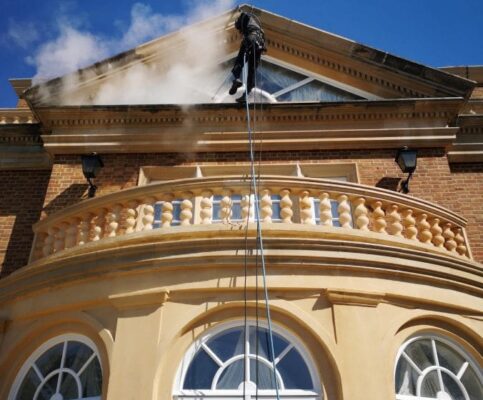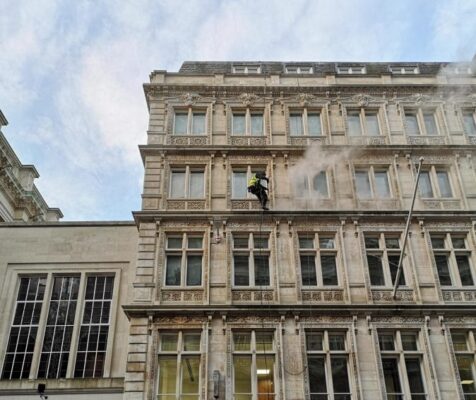View More SErvices Contact Us
Facade Cleaning in Addiscombe
Cleaning building facades from top to bottom, no matter how tall your building.
Natural stone facade cleaning in Addiscombe can be accessed and cleaned efficiently and effectively by using rope access methods. Using this method, the need for local authority permits is totally eradicated, allowing works to proceed immediately. Using professional stone cleaning equipment we can roll back the years to make your building look like new.
Brick cleaning
Brick buildings become dirty as much as any other building. We will not only clean away the dirt and grime, we can revitalise the colour. Using a range of bio-degradable chemicals, we can restore the colour of red or yellow bricks.
Contact UsGlass facade cleaning in Addiscombe
Glass facade cleaning in Addiscombe takes place by abseilers using traditional window cleaning tools. External windows, internal atriums, after builders cleaning or regular maintenance cleans, our abseilers are experienced in all manner of glass cleaning.
Contact UsAluminium cladding cleaning
Aluminium cladding in Addiscombe can become extremely dirty over time. Warehouses that have many lorries coming and going will become soiled with traffic film. Using our steam cleaning systems, this grime is washed away leaving a lasting first impression for your visitors.
Contact UsOur services
Rope Access Facade Cleaning Services for Addiscombe And Surrounding Counties

Residential property Stone Facade Cleaning
Façade cleaning at this residential property in Addiscombe, which was not of any great height but, had no access for other forms of access equipment. Abseiling was the solution and the results were outstanding.

Stone Steam Cleaning in London
This beautiful natural stone building was looking tired from the day to day London traffic. Rope access was seen as the most cost-effective method of access.

Concrete Facade Cleaning in Addiscombe
This car park in Essex was filthy. It hadn’t been cleaned, ever. As the access to three elevations was extremely tight, abseiling was the only method that could achieve the results.

Facade Cleaning in Addiscombe
A new acquisition for our client needed a freshen up. Out of hours abseiling was the best way to clean this building in the heart of the City of London.
Brick colour restoration
Before colour restoration
This client requested a test patch before assigning us the job of cleaning their building. We carried this out with amazing results.
After colour restoration
These are the pictures of the test patch that we sent to the client. Her reaction was simply ‘WOW’. That’s the perfect response for us.
Torik Stone Cleaning System Features
150 degrees centigrade steam cleaning power
Provides a continues flow of superheated water to penetrate stone and deep clean, removing organic growth & ground in dirt.
We use Tensid (uk) Ltd
Providers of specialist cleaning equipment and specialist cleaning chemicals to professionals.
Get In Touch
Fill in the form below and we’ll be in touch within 24hrs of receiving your message.
Facts About Addiscombe
Addiscombe History
First mentioned in the 13th century, Addiscombe formed part of Croydon Manor and was known as enclosed land belonging to Eadda. The area was a rural and heavily wooded area, remaining so until the late 19th century. Its main industries were farming and brick-making, clay deposits at Woodside providing the raw materials for the latter.
After the death of Sir Purbeck in 1695 and his wife Dame Sarah Temple in 1700, the estate passed to Dame Sarah’s nephew, William Draper, who was married to the daughter of the famous diarist, John Evelyn. When Draper died in 1718, he left his estate to his son of the same name and it then passed to his nephew, Charles Clark.
General Info
Addiscombe is an area of south London, England, within the London Borough of Croydon and the historic county of Surrey. It is located 9.1 miles south of Charing Cross, and is situated north of Coombe and Selsdon, east of Croydon town center, south of Woodside, and west of Shirley.
Addiscombe as a place name is thought to be Anglo-Saxon in origin, meaning “Eadda or Æddi’s estate”, from an Anglo-Saxon personal name, and the word camp, meaning an enclosed area in Old English. The same Anglo-Saxon land-owner may have given his name to Addington, around two miles to the south.



